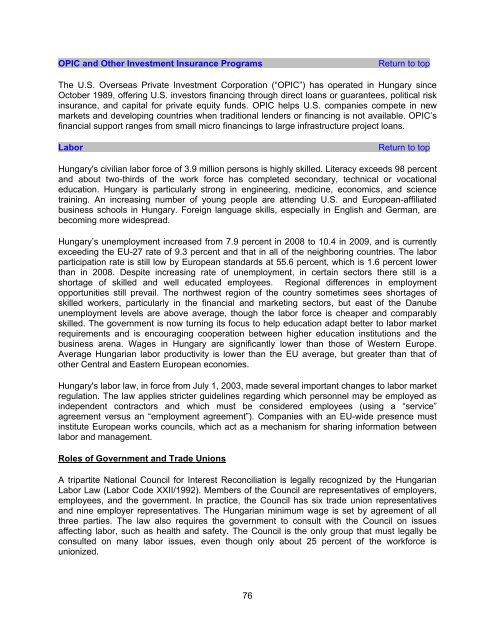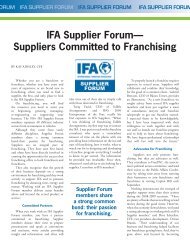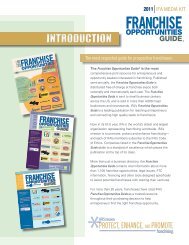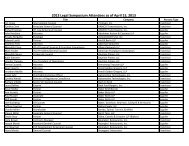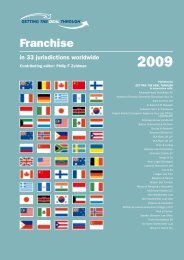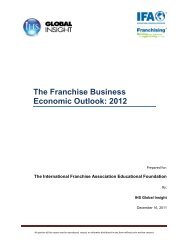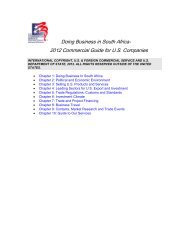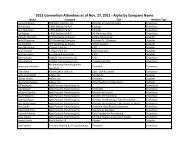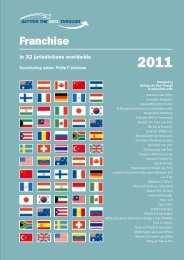Doing Business in Hungary 2010 - International Franchise Association
Doing Business in Hungary 2010 - International Franchise Association
Doing Business in Hungary 2010 - International Franchise Association
Create successful ePaper yourself
Turn your PDF publications into a flip-book with our unique Google optimized e-Paper software.
OPIC and Other Investment Insurance Programs Return to top<br />
The U.S. Overseas Private Investment Corporation (“OPIC”) has operated <strong>in</strong> <strong>Hungary</strong> s<strong>in</strong>ce<br />
October 1989, offer<strong>in</strong>g U.S. <strong>in</strong>vestors f<strong>in</strong>anc<strong>in</strong>g through direct loans or guarantees, political risk<br />
<strong>in</strong>surance, and capital for private equity funds. OPIC helps U.S. companies compete <strong>in</strong> new<br />
markets and develop<strong>in</strong>g countries when traditional lenders or f<strong>in</strong>anc<strong>in</strong>g is not available. OPIC’s<br />
f<strong>in</strong>ancial support ranges from small micro f<strong>in</strong>anc<strong>in</strong>gs to large <strong>in</strong>frastructure project loans.<br />
Labor Return to top<br />
<strong>Hungary</strong>'s civilian labor force of 3.9 million persons is highly skilled. Literacy exceeds 98 percent<br />
and about two-thirds of the work force has completed secondary, technical or vocational<br />
education. <strong>Hungary</strong> is particularly strong <strong>in</strong> eng<strong>in</strong>eer<strong>in</strong>g, medic<strong>in</strong>e, economics, and science<br />
tra<strong>in</strong><strong>in</strong>g. An <strong>in</strong>creas<strong>in</strong>g number of young people are attend<strong>in</strong>g U.S. and European-affiliated<br />
bus<strong>in</strong>ess schools <strong>in</strong> <strong>Hungary</strong>. Foreign language skills, especially <strong>in</strong> English and German, are<br />
becom<strong>in</strong>g more widespread.<br />
<strong>Hungary</strong>’s unemployment <strong>in</strong>creased from 7.9 percent <strong>in</strong> 2008 to 10.4 <strong>in</strong> 2009, and is currently<br />
exceed<strong>in</strong>g the EU-27 rate of 9.3 percent and that <strong>in</strong> all of the neighbor<strong>in</strong>g countries. The labor<br />
participation rate is still low by European standards at 55.6 percent, which is 1.6 percent lower<br />
than <strong>in</strong> 2008. Despite <strong>in</strong>creas<strong>in</strong>g rate of unemployment, <strong>in</strong> certa<strong>in</strong> sectors there still is a<br />
shortage of skilled and well educated employees. Regional differences <strong>in</strong> employment<br />
opportunities still prevail. The northwest region of the country sometimes sees shortages of<br />
skilled workers, particularly <strong>in</strong> the f<strong>in</strong>ancial and market<strong>in</strong>g sectors, but east of the Danube<br />
unemployment levels are above average, though the labor force is cheaper and comparably<br />
skilled. The government is now turn<strong>in</strong>g its focus to help education adapt better to labor market<br />
requirements and is encourag<strong>in</strong>g cooperation between higher education <strong>in</strong>stitutions and the<br />
bus<strong>in</strong>ess arena. Wages <strong>in</strong> <strong>Hungary</strong> are significantly lower than those of Western Europe.<br />
Average Hungarian labor productivity is lower than the EU average, but greater than that of<br />
other Central and Eastern European economies.<br />
<strong>Hungary</strong>'s labor law, <strong>in</strong> force from July 1, 2003, made several important changes to labor market<br />
regulation. The law applies stricter guidel<strong>in</strong>es regard<strong>in</strong>g which personnel may be employed as<br />
<strong>in</strong>dependent contractors and which must be considered employees (us<strong>in</strong>g a “service”<br />
agreement versus an “employment agreement”). Companies with an EU-wide presence must<br />
<strong>in</strong>stitute European works councils, which act as a mechanism for shar<strong>in</strong>g <strong>in</strong>formation between<br />
labor and management.<br />
Roles of Government and Trade Unions<br />
A tripartite National Council for Interest Reconciliation is legally recognized by the Hungarian<br />
Labor Law (Labor Code XXII/1992). Members of the Council are representatives of employers,<br />
employees, and the government. In practice, the Council has six trade union representatives<br />
and n<strong>in</strong>e employer representatives. The Hungarian m<strong>in</strong>imum wage is set by agreement of all<br />
three parties. The law also requires the government to consult with the Council on issues<br />
affect<strong>in</strong>g labor, such as health and safety. The Council is the only group that must legally be<br />
consulted on many labor issues, even though only about 25 percent of the workforce is<br />
unionized.<br />
76


